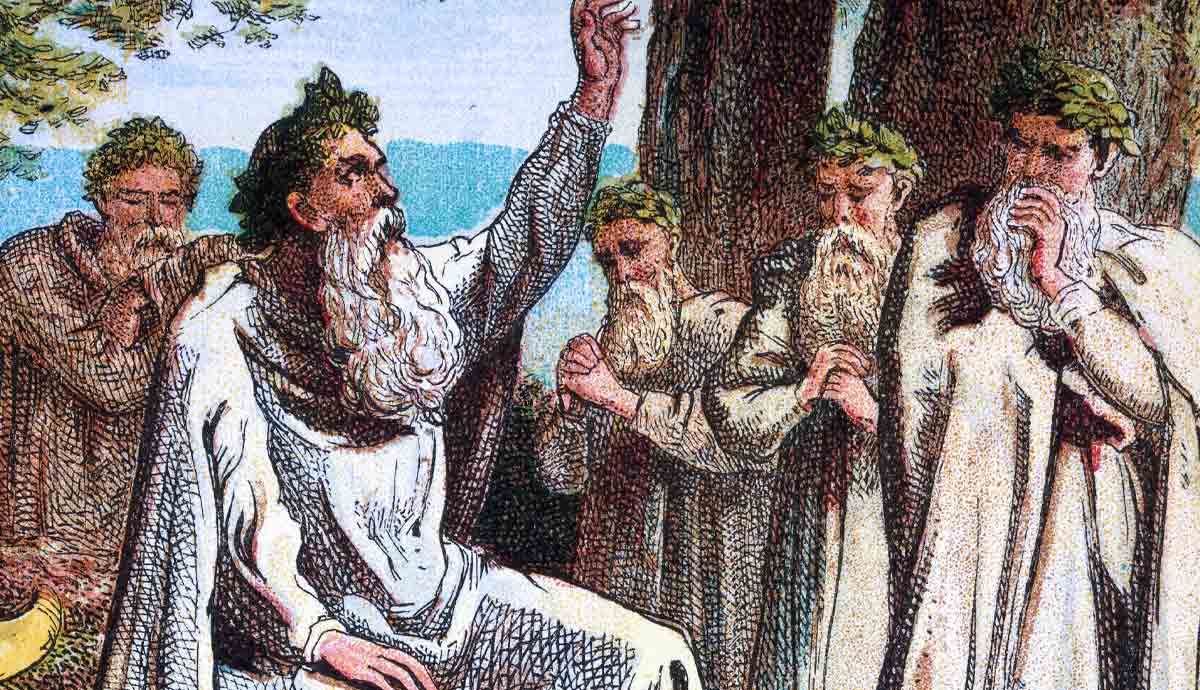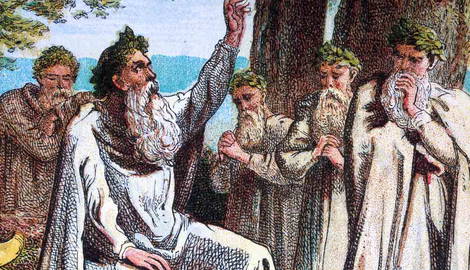
Mist and magic surround many modern interpretations of the druids. Their existence in popular culture has also created a stereotype and mythology of religious specialists with supernatural powers, divination prowess, and the ability to cast spells. This article will consider how far this image is justified from historical sources and archaeology by looking at the writings of Caesar and Tacitus and some very strange Iron Age spoons!
The History of the Druids

Historical sources about the druids are limited and their depictions are cloaked in Roman propaganda in which they are often portrayed as barbaric. Sadly, due to the oral nature of druidic teachings, there is no written record from the Iron Age druids themselves, and we therefore have to rely on the Roman accounts and inferences gained from the scarce archaeological record. One description of the druids comes from Julius Caesar in his Gallic Wars. In this book, Caesar recounted his experiences during the Gallic Wars in France and his invasion of southern Britain in which he encountered firsthand, the indigenous tribal groups. He describes the druids as being concerned with divine worship, performing sacrifices, and ruling on societal disputes when sat in a designated sacred spot at certain times during the year.
Caesar also wrote that the druids originated in Britain, most likely on the isle of Anglesey (Mona) in Wales, and from there, they completed their training of around twenty years before returning to, or being sent to Gaul. Furthermore, a chief druid was elected for the duration of their life, and only upon their death, would a new chief be appointed. If multiple druids were of equal status, then a vote would be held.
During his time in Britain, Caesar also recounted a tale concerning the use of a wicker man. Caesar wrote an account that was apparently firsthand, although it is important to note that many Roman writers would reference other works and attempt to pass them off as a firsthand account. His commentary, however, included a description of a large wickerwork structure that was stuffed with living people and lit ablaze; he also detailed how criminals were the favored sacrifices, although, in their absence, innocents could also be used. This description has captured imaginations for millennia, but especially of those back in Rome where the funding for Caesar’s wars was coming from. There was a definitive need for Caesar to depict the Germanic, Gaulish, and British tribes as barbaric — to create a sense of otherness. This was because his campaigns relied heavily on funding from Rome and he had a need to justify his reasons for continuing his expansion.
The Destruction of Anglesey

Thanks to Caesar’s accounts of the origins of the druids in Britain, it became of great importance for Rome to crush their power in order to subdue potential uprisings. It was not, however, until around a century later, in 60 or 61 CE, when Suetonius Paulinus led a successful attack on the island, that the druids of Anglesey faced a direct assault on their center of power.
Tacitus provides a compelling account of the druids clad in black robes in the guise of furies, with hands held to the sky and chanting imprecations that paralyzed the Romans to the point that they exposed themselves to wounds without any attempt at defense. Eventually through rallying the soldiers, they were able to overcome the druid resistance and started to decimate the sacred groves. Before the destruction was complete, the army was called away from Anglesey in order to face the rebellion in eastern England of the Iceni queen Boudicca, who had allied with the neighboring Trinovantes.
Due to the premature withdrawal of the Roman army to face Boudicca, it was not until 78 CE that the second invasion of Anglesey completely pacified the druidic resistance. Gnaeus Julius Agricola had become the Roman governor of Britain and heard that the Ordovices of Wales had destroyed the local cavalry unit. This attack on Roman power was enough for Agricola to launch a second invasion of the island in order to completely pacify the population. This final and decisive strike led to three centuries of Roman governing of the island.
The Archeology of the Druids

Another potential source of information regarding the existence and function of the druids is through archeology. There is, however, a definite lack of direct archeological evidence, and their presence can only be inferred through certain unusual burials or from shrines; it is important to note that the existence of a shrine does not directly imply the existence of a druid, as anyone could have made use of the shrine without having received the extensive education over many years in druidic practices.
One possible source that could tentatively suggest the existence of a religious specialist is the discovery of pairs of unusual bronze spoons from burials that may have been used as a piece of divination equipment. These spoons have been found predominantly in Britain and are often shallow, oval-shaped bowls that appear to have been designed to fit comfortably into the palm of an adult hand. There is always a hole drilled off-center in one spoon, while the other features a cross that divides it into four quarters. It has been suggested that a liquid such as water, blood, or beer may have been poured through the hole of the first spoon and then allowed to drip onto the second spoon in some form of divination practice. Early interpretations of the spoons suggested that they were, in fact, Christian and were used for delivering the eucharist or for baptism, although these interpretations have since been discounted due to modern dating methods.
The idea of druids engaging in divination is also supported by some of the historical sources. The difference, however, is that the Roman sources tended to vilify the practice by suggesting that after a human was sacrificed, their entrails would be examined as a form of barbaric divination. This evidences the idea of druidic divination, although the method for carrying out the practice is clearly very different.
Druids in the Popular Imagination

Due to the so-called ‘Celtic revival,’ a desire to trace ancestry back to Iron Age peoples has created waves of interest in the languages, culture, and religions that existed in this period. In Britain, this interest was spearheaded by William Stukeley in the mid-1740s with his publication of two volumes surrounding his research on Stonehenge and Avebury. He concluded that virtually all stone circles, alignments, and tombs were ascribed to the druids and that the hillforts were either strongholds or the camps of Caesar during his conquest of Britain. As we now know, stone circles, alignments, and tombs in fact date back to the Neolithic and were therefore in existence long before the arrival of the Iron Age in Britain (Cunliffe 2018, 16).

A revivalism of Druidry began in the 19th century with a very tenuous link to how it was practiced during the Iron Age. This was mainly due to the biases present in historical sources and the lack of archaeological evidence. Over time, the ideas of modern Druidry progressed, and it now has a wide following of those interested in the ancient ways with a focus on the preservation of nature, community service, and a general polytheistic belief system. The modern incarnation of Druidry must of course, abide by modern laws and social norms which certainly reduces the emphasis on human sacrifice and the public use of bladed weapons!
Did the Druids Actually Exist?

Even with the wealth of study on the subject of druids and the Iron Age, this is still a very difficult question to answer. On one hand, there is strong evidence from historical sources that a caste of educated leaders existed in order to assist the general population of each tribe. On the other hand, there is a lack of archaeological evidence to directly prove that they existed in the form exhibited in Roman writings.
Inferences can be made around possible divination equipment, such as the spoons which are occasionally found in Iron Age burials, although this is far from conclusive evidence. It seems likely, however, that Iron Age societies were separated into different classes, and it is therefore probable that the druids did hold a deal of power over their respective tribes, although this power was likely to have been through their education and political sway rather than from directly channeling supernatural forces.
What is certain is that the idea of the druid has captured the imaginations of people over the last few hundred years and many modern druids consider themselves as the inheritors of an ancient practice that first appeared as far back as the Iron Age; modern practices are ‘a best guess’ at what existed during this period from the scarce archaeological traces coupled with Roman sources.
Further Suggested Reading
Caesar, J. Translated by Edwards, J H. (1917). Julius Caesar: Gallic Wars. Laskaridis Foundation. https://topostext.org/work/683
Cunliffe, B. (2018). The Ancient Celts. 2nd Edition. Oxford: Oxford University Press.
Druid Network. (2024). An Introduction to the Basics of Modern Druid Practice. The Druid Network. https://druidnetwork.org/what-is-druidry/learning-resources/shaping-the-wheel/introduction-basics-modern-druid-practice/
Fitzpatrick, A. (2007). Druids: Towards an Archaeology. In Gosden,C et al (Eds). Communities and Connections: Essays in Honour of Barry Cunliffe. Oxford: Oxford University Press.










